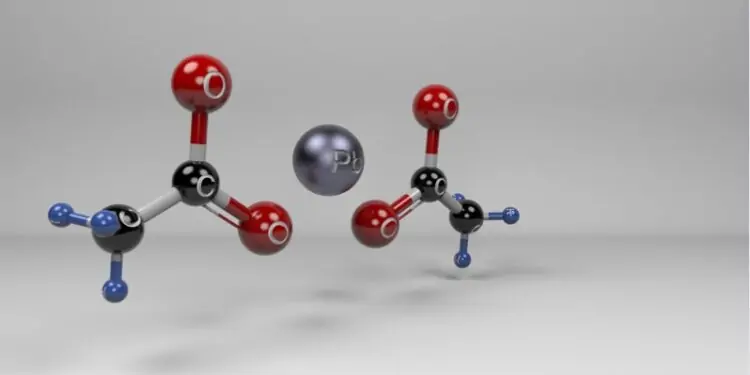Education
The Science Behind Acetatas: What You Need to Know

Acetatas, also known as acetates, are salts or esters of acetic acid. These compounds are commonly used in various industries due to their versatile nature and properties. In biology, acetate plays a crucial role as it is involved in processes like the fermentation of acetyl CoA to acetate. This conversion is essential for energy production in cells.
The fermentation of acetate itself is another significant biological process where it serves as a substrate for microorganisms to produce energy through metabolic pathways. Structurally, acetatas consist of an acetyl group linked to a molecule containing oxygen – giving them their unique chemical composition. The uses of acetatas are diverse, ranging from being used as solvents and additives in the manufacturing industry to serving as precursors in pharmaceuticals and food processing. Their properties make them valuable substances with wide-ranging applications across different sectors.
Acetatas
Acetatas are a class of organic compounds that play essential roles in various fields, from chemistry to biology. These versatile molecules consist of acetate ions and can exist in the form of salts or esters. The nomenclature for acetatas typically includes the term “acetate” followed by the name of the cation with which it is combined.
In biology, acetate is involved in crucial metabolic processes. One example is the fermentation of acetyl CoA to acetate, which occurs during certain energy-producing reactions within cells. Acetate itself can also be further fermented by organisms into other substances for energy production.
The structure of acetatas is relatively simple yet important due to their wide range of uses. From being utilized as solvents and preservatives to serving as an intermediate in chemical synthesis, acetatas have diverse applications across industries.
Nomenclature and Common Formula
When it comes to acetatas, understanding the nomenclature and common formula is essential in grasping its chemical composition. The term “acetate” refers to the ion resulting from the deprotonation of acetic acid. In chemistry, acetates are salts or esters of acetic acid.
The common formula for acetate is CH₃COO⁻, representing a negative charge on the carbon atom due to gaining an electron pair through deprotonation. This simple yet crucial structure defines how acetates interact with other molecules in various processes.
Salts
Salts are compounds formed when an acid reacts with a base, resulting in the release of water and formation of an ionic bond. These substances play a crucial role in various industries, from food preservation to pharmaceuticals. Common examples include table salt (sodium chloride) and Epsom salt (magnesium sulfate).
Salts can have different properties depending on their chemical composition. Some salts are soluble in water, while others may be insoluble. The pH of a solution containing salts can also vary based on the nature of the ions present.
In chemistry, salts are classified based on their cationic and anionic components. This classification helps scientists understand how these compounds behave under different conditions.
Esters
Esters are organic compounds derived from an acid (usually a carboxylic acid) and an alcohol. They are known for their pleasant fruity aroma, making them commonly used in perfumes, flavorings, and fragrances. The process of forming an ester involves a reaction between the carboxyl group of the acid and the hydroxyl group of the alcohol.
The name of an ester typically comes from the alcohol and acid it is derived from. For example, methyl acetate comes from methanol and acetic acid. Esters contribute to the characteristic flavors in fruits such as bananas, pineapples, and strawberries.
Acetate in Biology
Acetate plays a crucial role in biology as it is a key component in various metabolic pathways within living organisms. In biological systems, acetate can be found in the form of acetyl-CoA, which acts as an important molecule for energy production through cellular respiration. Acetyl-CoA is involved in the citric acid cycle, where it participates in generating ATP – the cell’s primary energy source.
Moreover, acetate also serves as a precursor for fatty acid synthesis and cholesterol biosynthesis. These processes are essential for maintaining cell membrane integrity and hormone production. Additionally, acetate can be utilized by certain bacteria as a carbon source during fermentation processes.
The presence of acetate in biology highlights its significance in sustaining life functions and biochemical reactions within cells. Its versatile nature makes it indispensable for various metabolic activities that support cellular growth and maintenance.

Fermentation of Acetate
Acetate is a key player in the process of fermentation, where it undergoes various transformations. During fermentation, acetate can be metabolized by microorganisms into different compounds that play essential roles in biological processes.
In the absence of oxygen, certain bacteria and other organisms utilize acetate as a substrate for energy production through fermentation. This process involves breaking down acetate molecules to generate ATP, the cell’s energy currency.
Through fermentation of acetate, microbial communities contribute to cycling carbon within ecosystems and aiding in nutrient availability for other organisms. These interactions are crucial for maintaining ecological balance and supporting diverse life forms.
By understanding the intricate pathways involved in the fermentation of acetate, researchers gain insights into how microbes interact with their environment and impact global biogeochemical cycles. Fermentation of acetate represents a fascinating biochemical process with implications for both environmental sustainability and human health.
Structures
Acetatas come in various structures, each with its own unique arrangement of atoms. The acetate ion, for example, is a simple structure consisting of two carbon atoms bonded to three oxygen atoms. This basic unit can form salts and esters through chemical reactions.
In biological systems, acetate plays a crucial role as acetyl CoA in metabolic pathways. It serves as an important building block for the synthesis of lipids and other biomolecules essential for cellular function.
The fermentation process involves the conversion of acetyl CoA to acetate by certain microorganisms. This transformation is vital in generating energy and maintaining metabolic balance within cells.
Understanding the structures of acetatas is key to grasping their diverse uses across industries such as pharmaceuticals, food production, and environmental remediation. By studying these molecular configurations, scientists can harness the properties of acetatas for various applications.
Uses Of Acetatas Acid
Acetatas acid, commonly known as acetate, is a versatile compound with various practical applications across different industries. One of the primary uses of acetate acid is in the production of textiles. It serves as a key component in creating acetate fabric, which is widely used for making clothing and household items like curtains.
In the realm of food preservation, acetate acid plays a crucial role as a preservative to extend the shelf life of products such as pickles and sauces. Its antimicrobial properties help inhibit the growth of harmful bacteria, keeping food safe for consumption.
Moreover, acetate acid is utilized in the manufacturing of pharmaceuticals and cosmetics due to its ability to adjust pH levels and serve as a buffering agent. This makes it an essential ingredient in many medications and beauty products on the market.

Properties of Acetatas
Acetatas, also known as acetate compounds, possess unique properties that make them essential in various industries. These compounds typically have a pungent odor and are soluble in water, making them versatile for different applications.
One key property of acetatas is their ability to act as effective solvents due to their high solubility in both polar and nonpolar substances. This characteristic makes them valuable in the production of paints, adhesives, and pharmaceuticals.
Moreover, acetate compounds exhibit good thermal stability, allowing them to withstand high temperatures without decomposition. This property is particularly advantageous in the manufacturing of plastics and textiles where heat resistance is required.

Uses of Acetatas
Acetates are versatile compounds with numerous uses across various industries. One common application of acetates is in the production of plastics, where they act as plasticizers to improve flexibility and durability. Acetates are also used in the textile industry for dyeing fabrics, thanks to their ability to enhance color retention.
In the food industry, acetates serve as preservatives and acidity regulators in products like pickles and sauces. Additionally, acetates are found in cleaning products due to their excellent solvent properties that help remove dirt and grease effectively. In pharmaceuticals, acetates play a role in medication formulations.
Furthermore, acetates find applications in cosmetics for creating fragrances and as additives for skincare products. Their versatility extends to the agricultural sector where they are utilized as growth regulators for plants. The diverse uses of acetatas highlight their significance across multiple fields.
Production of Acetatas
Acetatas are produced through various methods, with one common approach being the reaction of acetic acid with an alcohol or base. This process typically involves mixing acetic acid with a specific reactant under controlled conditions to yield the desired acetate product. The production of acetates can also involve the esterification of acetic acid with alcohols, resulting in a wide range of acetate esters used in different industries.
Another method for producing acetates is through fermentation processes where certain microorganisms convert sugars into acetic acid, which can then be further processed into acetates. Additionally, some acetates are obtained from natural sources like fruits and plants, which contain naturally occurring forms of these compounds.
Understanding the various production methods for acetatas is crucial for industries utilizing these compounds in diverse applications ranging from pharmaceuticals to food additives.
Environmental Impact of Acetatas
Acetates have various applications across industries, but it’s essential to consider their environmental impact. When acetates are not disposed of properly, they can contribute to water and soil contamination. Improper disposal can lead to harmful effects on aquatic life and plants, disrupting ecosystems.
The production process of acetates also warrants attention when considering environmental impact. Energy consumption and emissions during manufacturing can add to the carbon footprint. It’s crucial for industries using acetates to implement sustainable practices and proper waste management protocols to minimize environmental harm.
Conclusion
Acetatas play a vital role in various industries and biological processes. From their nomenclature and common formulas to their production and environmental impact, acetates are versatile compounds that have widespread applications. Understanding the science behind acetatas is essential for grasping their significance in chemistry, biology, and industry.
Whether it’s being utilized as salts or esters, participating in fermentation processes, or serving as a key component in the production of different products, acetates demonstrate remarkable versatility. Their properties make them valuable for a range of uses while also highlighting the importance of considering their environmental impact.
By delving into the intricacies of acetatas – from their structures to their properties – we gain insight into how these compounds function and contribute to various aspects of our world. As research continues to uncover more about acetates, we can expect further innovations and advancements that harness the power of these intriguing substances for diverse applications.
Education
Educators for 188000: Transforming Learning Experiences

In the ever-evolving landscape of education, the initiative “188000: Transforming Learning Experiences” stands out as a beacon of innovation and progress. This groundbreaking program is designed to revolutionize traditional educational practices, offering educators a toolkit for creating more dynamic, engaging, and effective learning environments. Here’s a deep dive into what “188000” is all about and how educators can be at the forefront of this transformative movement.
What is 188000: Transforming Learning Experiences?
“188000: Transforming Learning Experiences” is an ambitious educational initiative aimed at reshaping how teaching and learning are approached in today’s classrooms. The program focuses on harnessing advanced technologies, personalized learning strategies, and collaborative methods to enhance educational outcomes and student engagement.
The initiative is named “188000” to signify the vast potential impact of rethinking and reimagining educational practices on the future of learning—suggesting a transformation that reaches far and wide.
Core Objectives of the Initiative
The initiative is built on several core objectives that drive its mission:
- Enhancing Learning Outcomes: By integrating innovative teaching practices, the program aims to boost student engagement and achievement. This involves adopting new pedagogical strategies that resonate with today’s learners.
- Integrating Technology: The initiative encourages the use of cutting-edge technology to support and enrich the learning process. This includes everything from interactive software and apps to advanced digital tools that facilitate personalized learning experiences.
- Personalizing Education: Recognizing that every student learns differently, the initiative promotes tailoring educational experiences to individual needs and learning styles. This personalized approach helps address diverse learning requirements and enhances student success.
- Fostering Collaboration: Collaborative learning is emphasized, encouraging students to work together, share ideas, and develop communication skills. This approach not only improves learning outcomes but also prepares students for real-world teamwork.
Opportunities for Educators
Educators play a pivotal role in the success of “188000: Transforming Learning Experiences.” Here’s how they can get involved:
- Professional Development: Educators can participate in a variety of professional development workshops and training sessions. These are designed to equip teachers with new skills and strategies to implement in their classrooms.
- Implementing Innovative Strategies: By applying the new techniques and tools provided through the initiative, educators can enhance their teaching methods and create more engaging learning environments for their students.
- Sharing Insights: The initiative provides platforms for educators to connect and collaborate with peers. By sharing experiences, insights, and best practices, educators contribute to a broader community of innovation and improvement.
- Providing Feedback: Educators are encouraged to offer feedback on the tools and strategies provided. This feedback helps refine the initiative and ensures that it meets the evolving needs of the educational community.
Resources Available
To support educators in their transformative journey, “188000” offers a range of resources:
- Workshops and Training: Interactive sessions focusing on modern teaching techniques and technologies.
- Online Courses: Access to comprehensive online modules covering various aspects of educational innovation.
- Teaching Tools: Educational software, apps, and other resources designed to enhance teaching and learning.
- Collaborative Platforms: Forums and networks where educators can share ideas, discuss challenges, and collaborate on projects.
Getting Involved
Becoming part of “188000: Transforming Learning Experiences” is straightforward. Educators can start by:
- Joining Workshops: Enroll in workshops and training sessions to gain new skills and insights.
- Implementing Strategies: Begin using the provided tools and strategies in your classroom.
- Engaging with the Community: Participate in forums and collaborative platforms to connect with other educators.
- Providing Feedback: Share your experiences and suggestions to help improve the initiative.
Staying Updated
To stay informed about the latest developments and opportunities, educators should:
- Subscribe to Newsletters: Regular updates and information about upcoming events.
- Follow on Social Media: Stay connected through the initiative’s social media channels.
- Check the Website: Regularly visit the initiative’s website for news, resources, and updates.
FAQ:
1. What is “188000: Transforming Learning Experiences”?
“Educators for 188000” Transforming Learning Experiences” is an innovative educational initiative aimed at redefining how teaching and learning occur in the 21st century. The program focuses on integrating advanced technologies, personalized learning strategies, and collaborative methods to create more engaging and effective learning environments.
2. Who can participate in this initiative?
Educators, administrators, and instructional designers from various educational levels and institutions are encouraged to participate. Whether you are a classroom teacher, a school principal, or an educational consultant, this initiative offers valuable resources and opportunities for professional development.
3. What are the main goals of the initiative?
- Enhance Learning Outcomes: Improve student engagement and achievement through innovative teaching practices.
- Integrate Technology: Utilize cutting-edge technologies to support and enhance the learning process.
- Personalize Education: Tailor educational experiences to meet individual student needs and learning styles.
- Foster Collaboration: Encourage collaborative learning environments that support teamwork and communication skills.
4. How can educators get involved?
Educators can get involved by:
- Joining Workshops and Training: Participate in workshops, webinars, and training sessions offered by the initiative.
- Implementing Strategies: Apply the strategies and tools provided in your own teaching practice.
- Sharing Insights: Contribute to collaborative platforms and forums to share experiences and insights with other educators.
- Providing Feedback: Offer feedback on the tools and strategies to help refine and improve the initiative.
5. What resources are available for educators?
The initiative provides a range of resources including:
- Professional Development Workshops: Interactive sessions focused on new teaching methods and technologies.
- Online Courses: Access to online modules covering various aspects of modern education.
- Teaching Tools: Access to educational software, apps, and other tools designed to enhance learning.
- Collaborative Platforms: Forums and networks where educators can connect, share best practices, and collaborate on projects.
6. Are there any costs associated with participation?
Participation in most aspects of the initiative is free of charge. However, some advanced workshops or specialized courses may have associated fees. Detailed information about any potential costs will be provided ahead of time.
7. How can I measure the effectiveness of the strategies and tools provided
The initiative encourages educators to use a variety of assessment methods to gauge the effectiveness of new strategies and tools. This may include:
- Student Feedback: Collecting feedback from students regarding their learning experiences.
- Performance Metrics: Monitoring changes in student performance and engagement levels.
- Reflective Practice: Regularly reflecting on and evaluating the impact of new methods on your teaching practice.
8. Can I contribute my own ideas or innovations to the initiative?
Absolutely! The initiative values contributions from all educators. You are encouraged to share your own ideas, innovations, and best practices through the collaborative platforms and forums. Your contributions can help shape the future of the initiative.
9. Where can I find more information or support?
For more information or support, you can:
- Visit the Initiative Website: Access detailed information, resources, and contact details.
- Contact Support: Reach out to the support team via email or phone for any specific queries.
- Join the Community: Engage with other educators through online forums and discussion groups.
10. How do I stay updated on the latest developments and opportunities?
Stay updated by subscribing to newsletters, following the initiative’s social media channels, and regularly checking the website for news and updates. This will ensure you are informed about upcoming events, new resources, and other relevant information.
-

 Health4 months ago
Health4 months agoChicken Calories: Exploring Nutritional Benefits and Culinary Versatility
-

 Games4 months ago
Games4 months agoExploring the Fascinating World of HSNIME
-

 Blog4 months ago
Blog4 months agoUnlocking zVideo: Your Comprehensive Guide
-

 News4 months ago
News4 months agoRai Van: Discover Its Importance In Modern Transportation 2024
-

 Business4 months ago
Business4 months agoPrince Narula Digital PayPal: Your Ultimate Guide
-

 Entertainment4 months ago
Entertainment4 months agoHow to Use Hurawatch From Your PC — LoftyCoCo
-

 Fashion4 months ago
Fashion4 months agoYour First Eyelash Extensions Experience Awaits: A Guide to Luscious Lashes
-

 Games4 months ago
Games4 months agoWhat is Chancerne?
